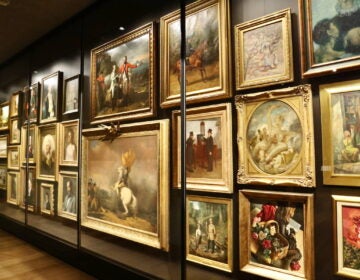Posthumously unsealed trove of T.S. Eliot letters reveals ill-fated relationship with Emily Hale
About 1,000 letters written by poet T.S. Eliot to confidante Emily Hale were unveiled Thursday, revealing an intense but ultimately thwarted love affair.

The crate pictured housed the collection for over 60 years and held a post-it note that read, 'Eliot/Hale, sealed until 2020.' (Shelley Szwast/courtesy of Princeton University Library)
After more than 60 years spent sealed up at a storage facility, about 1,000 letters written by poet T.S. Eliot to confidante Emily Hale were unveiled at a Princeton University library on Thursday, revealing an intense, ill-fated love affair that spanned decades but apparently was never consummated.
In 1956, Hale donated the letters under an agreement they wouldn’t be opened until 50 years after either her or Eliot’s death, whichever came second. Eliot died in 1965. Hale died four years later.
Eliot had the letters Hale sent to him destroyed. In his will, Eliot asked that Harvard publish his side of the story at the same time Hale’s collection was made public.

In dueling narratives about their relationship, the pair talk about the comfort they found in one another during Eliot’s unhappy marriage to his first wife, Vivienne Haigh-Wood. However, they offer conflicting portrayals of their intimate friendship.
For example, Hale wrote, “The memory of the years when we were most together, and so happy, are mine always. I am grateful that this period brought some of his best writing.”
In contrast, Eliot wrote, “Emily Hale would have killed the poet in me. Vivienne nearly was the death of me, but she kept the poet alive.”

Born in St. Louis in 1888, Eliot gained notoriety as a poet early in life. He was only 26 when his poem “The Love Song of J. Alfred Prufrock” was first published. He went on to write “The Waste Land,” “The Hollow Men” and “Four Quartets,” which are now considered classics.
Eliot’s 1939 book of whimsical poetry, “Old Possum’s Book of Practical Cats,” was adapted into “Cats,” the award-winning musical by Andrew Lloyd Webber.
Many scholars consider Hale to have been Eliot’s close friend and muse, but have wondered about the nature of their relationship.
Hale and Eliot exchanged letters for about 25 years, beginning in 1930. The two met in 1912 in Cambridge, Massachusetts, but did not rekindle their friendship until 1927. Eliot was already living in England. Hale taught drama at U.S. universities, including Scripps College in California.

While researchers hope the letters give insight to a wide range of topics — Eliot’s experiences as a writer, critic and editor; his conversion to Anglicanism; and his thoughts regarding the contemporary literary scene — a cursory viewing revealed ample material for those who have long wondered about the extent of their romantic involvement.
Hale wrote that Eliot first professed his love for her around 1913, before moving to Europe. Two years later, however, he married Cambridge governess Vivienne Haigh-Wood to, in his words, “burn my boats and commit myself to staying in England.” The pair separated in 1932, but stayed married until Haigh-Wood died in 1947 after spending a decade in a psychiatric hospital.
Eliot and Hale exchanged affectionate missives in the meantime. In one dated August 2, 1934, Eliot addressed Hale as “Dearest Lady” and wrote that “I would literally give my eyesight to be able to marry you, though unworthy of such happiness.”
Hale wrote that up until 1935, “I had no feeling except of difficult but loyal friendship.” In the ensuing years, however, the two spent summers together with her relatives in England, and “I found by now that I had in turn grown very fond of him,” she said.
It thus came as “both a shock and a sorrow” that Eliot decided not to marry her after his wife’s death, Hale wrote in her narrative. “Though, looking back on the story, perhaps I could not have been the companion in marriage that I hoped to be, perhaps the decision saved us both from great unhappiness.”
Eliot, for his part, wrote that upon his wife’s death, he suddenly realized he was not in love with Hale but rather with a memory of the experience of being in love with her in his youth.
“I came to see that my love for Emily was the love of a ghost for a ghost, and that the letters I had been writing to her were the letters of a hallucinated man, a man vainly trying to pretend to himself that he was the same man that he had been in 1914,” he wrote.
He added for good measure: “I might mention at this point that I never at any time had any sexual relations with Emily Hale.”
The collection of letters — housed in 14 boxes that also contain photographs, clippings and other ephemera — are copyrighted and won’t be made available online.

Daniel Linke, interim head of special collections at Princeton University Library, said in a recent Associated Press interview that he anticipated a rush on the archives by scholars from around the world.
“It will be the special collections equivalent of a stampede at a rock concert,” Linke said.
The stampede was of a genteel variety. Around midday Thursday, about half a dozen scholars pored over the letters in silence under a vaulted glass ceiling and circular chandeliers. Researchers could use laptops or library-provided loose-leaf paper to take notes. All cell phones and recording devices had to be stored securely in another room.
As scholars comb through the materials, more thorough analyses of their contents and significance are expected to come out in the weeks ahead.
This story contains material from the Associated Press.
WHYY is your source for fact-based, in-depth journalism and information. As a nonprofit organization, we rely on financial support from readers like you. Please give today.





